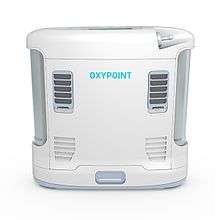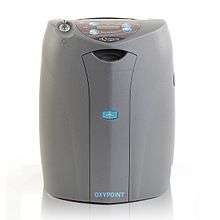Portable oxygen concentrator


Portable oxygen concentrator (POC) is a portable device used to provide oxygen therapy to chronic patients at greater oxygen concentrations than the levels of ambient air. It is similar to a home oxygen concentrator, but is smaller in size and more mobile. The portable oxygen concentrator makes it easy for patients to travel freely; they are small enough to fit in a car and many concentrators are now FAA-approved for use on airplanes.
Development
Oxygen concentrators were developed in the 1970s. Beginning in the 2000s, manufacturers developed portable versions. The first generation of POCs were bulky, unreliable, and were not permitted on airplanes. Since that time, reliability has been continuously improved, and POCs now produce between one and six liters per minute (LPM) of oxygen. The portable concentrators can be powered by grid electricity, by low-voltage vehicle electrical current, or from an internal battery.
How does it work?
Portable oxygen concentrators operate on the same principle as a home domestic concentrator, pressure swing adsorption. The atmosphere contains around 21% oxygen; the remainder is nitrogen and a mixture of other gases. An internal air compressor forces this air through a system of chemical filters known as a molecular sieve. This filter is made up of silicate granules called Zeolite which attract (via molecular bond adsorption) nitrogen molecules onto their surfaces more strongly than they attract oxygen molecules - this sieves the nitrogen out of the air, concentrating the oxygen. Part of the oxygen produced is delivered to the patient; part is fed back into the sieves (at greatly reduced pressure) to flush away the accumulated nitrogen, preparing the granule surfaces for the next cycle. Through this process, the system is capable of producing medical-grade oxygen of up to 90% consistently. The latest models can be powered from mains electricity supply, 12v DC (car/boat/aircraft), and battery packs, freeing the patient from relying on using cylinders or other current solutions that put a restriction on time, weight, and size.
Most of the current portable oxygen concentrator systems provide oxygen on a pulse (on-demand) delivery. The system supplies a high concentration of oxygen and is used with a nasal cannula to deliver the oxygen to the patient.
Benefits
POCs allow chronic oxygen therapy patients to maintain their mobility and independence throughout their day-to-day activities. Here are some benefits of using portable oxygen concentrators:[1]
- Allows patients to utilize oxygen therapy 24/7, which helps increase survival.
- Helps improve exercise tolerance, by allowing the user to exercise longer.
- Helps increase stamina throughout day-to-day activities.
- Freedom to travel lightly and easily. No need to carry around oxygen tanks.

In addition to this, portable oxygen has a variety of uses commercially; for example, for use in the glass-blowing industry, health clubs, beauty spas as well as airports.[2]
The difference between on-demand & continuous flow
On-demand (also called intermittent-flow or pulse-dose) POCs are the smallest, often no bigger than a briefcase or picnic cooler and weighing as little as 5 pounds (2.2 kg). These deliver oxygen only when patients inhale, avoiding the waste of oxygen during exhalation. Their ability to conserve oxygen is key to keeping the units so compact without sacrificing the duration of oxygen supply.[3] Slim carrying bags optimize the flexibility to take these units almost anywhere—even to altitudes of 10,000 feet—as long as there's sufficient battery run time or a power supply.
The most important consideration for a POC is its ability to supply adequate supplementary oxygen to relieve hypoxia (oxygen deficiency) during normal activities.[4] With continuous-flow units, oxygen delivery is measured in LPM (litres per minute). With on-demand or pulse-flow, delivery is measured by the size (in millilitres) of the "bolus" of oxygen per breath, referring to a burst of oxygen released at the instant of inhalation. Other variables include maximum oxygen purity (oxygen percentage), the number and increment of settings for adjusting oxygen flow, and battery capacity (or number of add-on batteries) and power cord options for recharging.
Although portable concentrators are a useful option for active patients, it is advisable to seek the assistance of a specialist, to prescribe the correct oxygen flow and choose a POC that best suits a patient's needs.[5]
A great deal of controversy has surrounded the use of POCs during sleep. On-demand units are typically not advised for patients with sleep apnea, who usually require a CPAP (Continuous Positive Airway Pressure) mask. For other patients, the nighttime use of POCs, especially with the advent of alarms and technology that detects a patient's slower breathing during sleep and adjusts the flow or bolus size accordingly.[6][3]
FAA approval
On 13 May 2009, the United States Department of Transportation (DOT) ruled that air carriers conducting passenger flights of greater capacity than 19 seats, must allow travelers with a disability to use an FAA-approved POC.[7] The DOT rules have been adopted by many international airlines. A list of POCs approved for air travel is on the FAA website.[7]
Future of Portable Oxygen Concentrators
The annual market for portable oxygen concentrators was at $242.5 million in 2012 and is expected to rise to $1.9 billion by year 2019. The growth is attributable to new competitors coming into the market, demand for the lighter technology by consumers, and the need of greater mobility support for the elderly. The competition is expected to drive innovation, resulting in lighter units and lower prices.[8]
Comparison of POCs
Intermittent flow (IF)-only products weighed in the range of from 2.8 to 9.9 pounds (1.3 to 4.5 kg). The continuous flow (CF) units were between 10 and 20 pounds (4.5 to 9.0 kg).[9]
POCs are suggested also for night use as they are able to alert patients if the expected inspiration ceases or is of insufficient strength; liquid oxygen therapy in continuous flow cannot detect the patient's inspiration phase.
See also
References
- ↑ "Portable Oxygen". Inogen Oxygen.
- ↑ Commercial uses of POC
- 1 2 "Continuous Flow vs. Pulse Dose". business.com. Home Medical Equipment Business. Retrieved 27 January 2015.
- ↑ Sam, Giordano. "Points to Ponder before Selecting a POC" (PDF). www.COPDfoundation.org. American Assoc. for Respiratory Care. Retrieved 27 January 2015.
- ↑ "Portable Oxygen Supply". DME Library. Retrieved 21 May 2016.
- ↑ Waters, Allison (7 November 2012). "Choosing the Best Portable Oxygen Concentrator: Start with the Flow". POC News & More. Retrieved 30 July 2014.
- 1 2 FAA Approves Portable Oxygen Concentrators
- ↑ Future of Portable Oxygen Concentrators
- ↑ A Guide to Portable Oxygen Concentrators, American Association for Respiratory Care (AARC), 2013, retrieved 12 April 2016